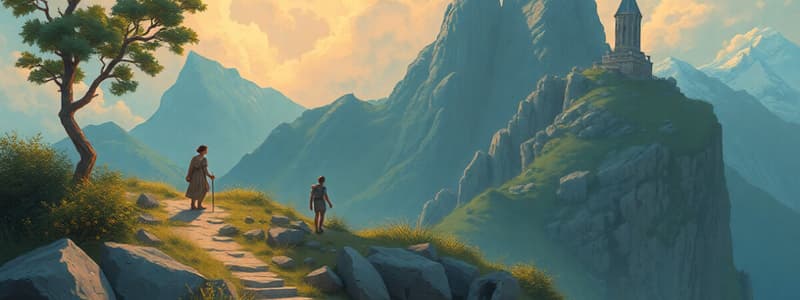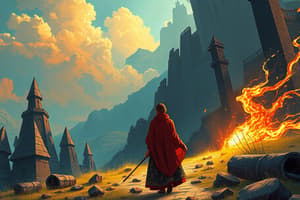Podcast
Questions and Answers
In literary communication, what element functions as the 'channel' through which the message is conveyed?
In literary communication, what element functions as the 'channel' through which the message is conveyed?
- The book or text (correct)
- The author
- The literary code
- The reader
Which literary genre is characterized by its subjective nature and abundant use of figures of speech?
Which literary genre is characterized by its subjective nature and abundant use of figures of speech?
- Dramatic genre
- Narrative genre
- Lyric genre (correct)
- Epic genre
What is the primary distinction between denotation and connotation in literary interpretation?
What is the primary distinction between denotation and connotation in literary interpretation?
- Denotation is indirect and suggestive, while connotation is direct and informative.
- Denotation is direct and informative, while connotation is indirect and suggestive. (correct)
- Denotation is emotional while connotation is rational.
- Denotation focuses on the theme, while connotation focuses on the argument.
Which feature is most characteristic of the dramatic genre?
Which feature is most characteristic of the dramatic genre?
Which of the following best describes 'literary creation' according to the text?
Which of the following best describes 'literary creation' according to the text?
What distinguishes poetic prose from regular prose?
What distinguishes poetic prose from regular prose?
The works 'Iliad' and 'Poema de Mio Cid' are examples of which literary subgenre?
The works 'Iliad' and 'Poema de Mio Cid' are examples of which literary subgenre?
What is the main characteristic of the narrative genre?
What is the main characteristic of the narrative genre?
The work of Abraham Valdeomar “El Caballero Carmelo”, is an example of what level of interpretation?
The work of Abraham Valdeomar “El Caballero Carmelo”, is an example of what level of interpretation?
Which of the following features is NOT considered a characteristic of the epic genre?
Which of the following features is NOT considered a characteristic of the epic genre?
Flashcards
Definition of Literature
Definition of Literature
One of the seven traditional arts, using language for aesthetic and moving purposes.
Literary Creation
Literary Creation
The art of words that combines reality and fantasy, often presented as fiction.
Denotation
Denotation
Direct, textual, and purely informative meaning of a word or phrase.
Connotation
Connotation
Signup and view all the flashcards
Verse
Verse
Signup and view all the flashcards
Prose
Prose
Signup and view all the flashcards
Poetic Prose
Poetic Prose
Signup and view all the flashcards
Literary Genres
Literary Genres
Signup and view all the flashcards
Epic Genre
Epic Genre
Signup and view all the flashcards
Dramatic genre
Dramatic genre
Signup and view all the flashcards
Study Notes
- Introduction to literature
Definition
- Literature is one of the seven traditional arts.
- It employs language with an aesthetic and moving purpose.
What is Literary Creation?
- It is the art of the word that combines reality and fantasy.
- It is always fiction.
Literary Communication
- Context: Represented reality
- Sender: Author, message: book/text, receiver: reader
- Code: literary language.
Levels of Interpretation
Denotation
- The meaning is direct, textual, and merely informative.
- The theme and argument are found here.
- Example: "El Caballero Carmelo" by Abraham Valdelomar is about a rooster that faces a younger one named Ajiseco.
Connotation
- Meaning is indirect, suggestive, and transcendent.
- The message of the work is found here.
- Example of connotation: "Slender, lean, muscular, and austere, his sharp red head was that of a proud hidalgo." - Abraham Valdelomar
Forms of Literary Language
Verse
- Generally used in poetry.
- Subject to rhythm, rhyme, meter, and poetic licenses.
- Example: "Youth, divine treasure, you leave never to return when I want to cry... I don't cry and sometimes I cry without wanting to" - Rubén Darío
Prose
- The most natural form of literary language.
- Predominates in narration.
Poetic Prose
- Subjective prose with musicality, rhythm, and subjectivity.
Literary Genres
- Categories used to classify literary works based on general characteristics (structure and content)
- Five literary genres exist: epic, lyrical, dramatic, narrative, and expository
- Epic, lyrical, and dramatic are classical genres
- Narrative and expository are modern genres
- San Marcos considers three literary genres: epic, lyrical, and dramatic.
- Literary genres are divided into species
Epic Genre
- Originates from the Greek "epos."
- Narrates deeds or adventures.
- Quality is superhuman.
- Supernatural elements are present.
- Gods can intervene.
Species include
- Epopeya: The Iliad (Homer)
- Cantar de gesta: Poema de Mio Cid (anonymous)
- Epic poem: La Cristiada (Diego de Hojeda)
Lyrical Genre (Poetry)
- Subjective
- Abundant literary figures.
- Usual form: verse, can also be lyrical prose
Species mentioned
- Rimas (Gustavo Adolfo Bécquer)
- Tristia (César Vallejo)
- Alma América (José Santos Chocano)
- Oda
- Elegía
- Égloga
- Sátira
- Madrigal
Dramatic Genre (Theater)
- Always has a funny character.
- Composed to be represented.
- Contains dialogues.
- Can be written in verse or prose.
Species include
- Tragedy: Antigone (Sophocles)
- Comedy: Tartufo (Moliere)
- Drama: Fuenteovejuna (Lope de Vega)
Narrative Genre
- Tell real or fictitious events.
- Contains descriptions.
- Written in prose.
Species include
- Cuento
- Novela
- Fábula
- Mito
- Leyenda
- Crónicas
Expository Genre
- Emerges in the Renaissance.
- Combines art and science.
- Always in prose
Species include
- Essay (Michel de Montaigne).
Studying That Suits You
Use AI to generate personalized quizzes and flashcards to suit your learning preferences.




